Schole. Философское антиковедение и классическая традиция @classics-nsu-schole
Статьи журнала - Schole. Философское антиковедение и классическая традиция
Все статьи: 733
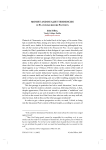
Monist and dualist tendencies in Platonism before Plotinus
Статья научная
The article by John Dillon (Trinity College, Dublin) is devoted to an interesting page in the history of adventure ideas. It traces the path made by metaphysics of the platonic sense from the "moderate monism" of Plato and the Ancient Academy, through the dualism of Plutarch and Noumenia, to the monistic position of Plotinus. Rus. trans. of this article, see ΣΧΟΛΗ ΙΙ. 1 (2008) 11-20.
Бесплатно
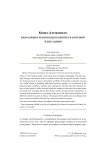
Moses Attikidzon: философия и религиозная политика в античной Александрии
Статья научная
“Библейское происхождение” основных идей эллинской философии. Эта идея, возможно, странная для современного читателя, была практически общепринятой в первые века нашей эры и восходит, по крайней мере, к Аристобулу и Филону Александрийскому. Одним из основных протагонистов этой концепции, действительно очень полезной для оправдания философии и обоснования правомерности включения ее в иудейско-христианское мироучение, следует считать Климента Александрийского, который не сомневается в том простом факте, что греческие мудрецы или позаимствовали свои учения непосредственно от самого Моисея и иудейских служителей, или же получили его свыше как откровение истинного Бога, которое поэтому не должно отличаться от закона, данного Моисею. Статья дополняется подборкой источников, иллюстрирующих историю перевода Библии на греческий язык.
Бесплатно
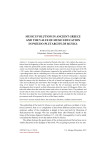
Music evolution in ancient Greece and the value of music education in pseudo-Plutarch's "De Musica"
Статья научная
A treatise De musica, ascribed to Plutarch (the 2nd c. AD), reflects the music evolution from the beginning of this art in archaic Greece until the early Hellenistic period. Initially, within the spiritual life and the education of the citizens the importance of music education was extremely high. Gradually, during the years, and even since the last part of the 5th c. BC, music, after centuries of dominance, appeared in the spiritual life of the Greeks not as a prevailing feature but as a subsiding one. It was even difficult to maintain its position in the educational system. The participants of the dialogue (the rich host Onesicrates, a musician Lysias and an educated man Soterichus) have been gathered to discuss, investigate and highlight the reasons why this decadence of the role of music has happened, by citing the musicians and recollecting the innovations they brought in the musical practise since the beginning of its history. In the book, apart from the list of musicians and the technical developments they invented, we find information about the views of Pythagoras, Plato, Aristotle and others about the value that music used to have in ancient Greece. The paideutic and moral value of music was the reason why it played a very important role in the education and the three men adopt the most traditionalistic approach and conclude that the technical improvements made it lost ground in favor of the literary studies.
Бесплатно
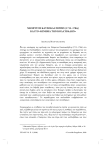
Neophytos Kausokalybites (1713-1784?) kai to "Kinema ton kollybadon"
Статья научная
Leonidas Bargeliotis (Athens) presents the essay "The Neofit Kafsokalivit (1713-1784?) And the movement of the collovads." As you know, this movement arose among the monks of Mount Athos who stood up for the protection of church customs and against those members of the "brethren" who wanted to earn money by selling their goods on the Saturday market and increasing the number of memorial services paid for by parishioners, agreeing to spend them on Sunday and holiday days. The neophyte was one of the protagonists of this movement, and to evaluate his role, the author of this article (1) gives an outline of the philosophical and theological conflicts of that time, (2) explores the religious rhetoric that accompanies the conviction of the monk Neophyte and his stubborn self-defense, and (3) shows the importance permanent relocations of the Neophyte for wide dissemination of the discussion in the Balkans and beyond.
Бесплатно
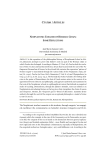
Neoplatonic Exegesis of Hermaic Chain: Some Reflections
Статья научная
In his exposition of the philosophical history of Neoplatonist School in Athens, Damascius attempts to prove that Isidore's soul was part of the Hermaic chain to which Proclus also belonged. According to Marinus (V. Procl. 28), Proclus had the revelation of this very fact and had learned from a dream that he possessed the soul of the Pythagorean Nicomachus of Gerasa. In the 4th and 6th centuries the expression “pattern of Hermes Logios” is transmitted through the various links of the Neoplatonic chain, Julian (Or. 7.237c), Proclus (in Parm. I.618), Damascius (V. Isid. Fr. 16) and Olympiodorus (in Gorg. 41.10.16–22; in Alc. 190.14–191.2). The formula that Aelius Aristides (Or. III.663) dedicates to the praise of Demosthenes, the best of Greek orators, arises in the context of an opposition between rhetoric and philosophy, and appears transferred and transmuted in the texts of the Neoplatonic schools to a philosophical context that defends an exegetical mode of teaching. Demosthenes, through his admirer Aristides, exerts an influence on Neoplatonism, introducing Hermes as the key piece that strengthens the chain of reason and eloquence. Hermes, the “eloquent” god or “friend of discourses”, transmits divine authority through the word of the exegete: an exceptional philosopher, a model of virtue to strive to rise to.
Бесплатно
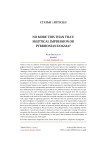
No more this than that: skeptical impression or Pyrrhonian dogma?
Статья научная
This is a defense of Pyrrhonian skepticism against the charge that the suspension of judgment based on equipollence is vitiated by the assent given to the equipollence in question. The apparent conflict has a conceptual side as well as a practical side, examined here as separate challenges with a section devoted to each. The conceptual challenge is that the skeptical transition from an equipollence of arguments to a suspension of judgment is undermined either by a logical contradiction or by an epistemic inconsistency, perhaps by both, because the determination and affirmation of equipollence is itself a judgment of sorts, one that is not suspended. The practical challenge is that, independently of any conceptual confusion or contradiction, suspending judgment in reaction to equipollence evinces doxastic commitment to equipollence, if only because human beings are not capable of making assessments requiring rational determination without believing the corresponding premises and conclusions to be true. The two analytic sections addressing these challenges are preceded by two prefatory sections, one laying out the epistemic process, the other reviewing the evidentiary context. The response from the conceptual perspective is that the suspension of judgment based on equipollence is not a reasoned conclusion adopted as the truth of the matter but a natural reaction to an impression left by the apparently equal weight of opposing arguments. The response from the practical perspective is that the acknowledgment of equipollence is not just an affirmation of the equal weight of arguments but also an admission of inability to decide, suggesting that any assent, express or implied, is thrust upon the Pyrrhonist in a state of epistemic paralysis affecting the will and the intellect on the matter being investigated. This just leaves a deep disagreement, if any, regarding whether equipollence is an inference based on discursive activity or an impression coming from passive receptivity. But this, even if resolved in favor of the critic (which it need not and ought not be), is not the same as confusion or inconsistency on the part of the Pyrrhonist, the demonstration of which is the primary aim of this paper.
Бесплатно
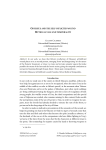
Odysseus and the self-inflicted wound mythical tale and temporality
Статья научная
In our work, we show that Helen's recollection of Odysseus' self-inflicted wound places us in an eternal present, emerging "from" and disappearing "in" the nature of the Homeric hexameter, et retour , to create and recreate semantic spaces that make possible the return of the hero and the heroic action, giving the temporal correlation an unexpected meaning through the past-future / future-past correspondence.
Бесплатно
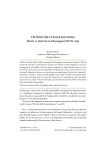
On stoic self-contradictions: vs. in Chrysippus (SVF III, 289)
Статья научная
In this article, I offer an analysis of Chrysippus’ treatment of “injustice” (ἀδικία) in SVF III, 289. First, I show that he espouses two theses: I) Every injustice is an act of harming those who suffer it; II) One who does injustice to others thereby does it to oneself. Then I discuss the two most plausible interpretations of II): a) One who does “conventional” injustice to others, i.e. causes them non-moral harm, thereby does “moralistic” injustice to oneself, i.e. makes oneself morally worse; b) One who does “moralistic” injustice to others thereby does it to oneself. I show that a) is untenable because the Stoics reject the very notion of non-moral harm, and b) fails because they believe that moral harm is basically self-regarding.
Бесплатно
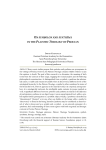
On symbolon and synthema in the platonic theology of Proclus
Статья научная
Many recent studies propose that symbolon and synthēma are synonymous in the writings of Proclus. However, his Platonic Theology contains reliable evidence to put this opinion to doubt. The goal of this research is to determine the meaning of both terms from the contexts of their usage, engaging the textual analysis and the following philosophical reconstruction. As distinguished from a symbol, a synthēma has substantial nature, is stable and remains invariable when is discovered at different levels of the ontological hierarchy. In the Platonic Theology, a symbol is often considered in terms of the hierarchic level, where it appears: in the material world, it is corporeal; among numbers, it is ontologically irrelevant, the intelligible realm contains its proper symbols as well. A significant difference between symbolon and synthēma is related to the dialectics of participation: synthēma in an object keeps it on an unparticipated level, while a symbol implies further participation to a symbolic object. Finally, a synthēma is described as “disseminated,” “planted,” or in any other way hidden in the being; while a symbol is “discovered,” or found in the being, therefore synthēma may be considered an inner kernel of what is discovered as a symbol, and a symbol - as an outward expression of a synthēma. Such understanding of these terms agrees with both exegetical and theurgic contexts in Proclus' Platonic Theology.
Бесплатно
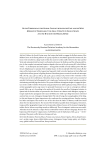
Статья научная
Before the Greek-Persian wars, the Ionians had tried to engage the Hellenic states of the Balkan Greece in the flaring advance of a group of poleis in Asia Minor against the Persian rule, the Ionic revolt resulted in a large-scale (within the ancient world) conflict between the East and the West and unleashed a half-century’s confrontation between the Hellenes and the Achaemenid Empire. In the complex international situation shaped at the turn of the 5th century BC in the Hellenic world — in its European and Asian parts — strong poleis needed not only military power but also the art of diplomacy to maintain their steadfast stance. In the second half of the 6th century BC the states of the Eastern part of the Aegean Sea frequently tried to involve Spartans in their affairs and exploit their military power in fighting Persians. Herodotus gives accounts of several such attempts: Hdt. 1.82–83; 1.152; 3.46–47 and 54–56; 3.148; 5.49–51 and 97; 6.84. Aware of the ‘enormity’ of the Persian wars in the world history, Herodotus chose a topic of a Homeric scale to be accounted of epically. His historical ad ethnographic text is made up of various myths, yarns, legends, anecdotes and amusing and edifying short stories. The tyrant of Miletus Aristagoras sought to engage the Spartans in the conflict with the Persians by using peculiar bronze tablet (khalkeos pinax), which was an archaic geographic proto-map meant to persuade Cleomenes to set out on a dangerous military march (Hdt. 5.49–50). According to the author of the article, the novella of Aristagoras’ mission in Sparta and the bronze tablet are presented in the Histories as a drama: with dialogues, urgings, attempts made by the protagonist (the tyrant of Miletus) he tried to get King Cleomenes interested and win him over, yet, Aristagoras’ designs failed. The role of Gorgo, the young daughter of the King, in this mini-drama is of great importance: she condemns the cunning petitioner, thereby rescuing her father and Sparta. This must be one of the tales that the Father of History could have heard about the wise Spartan Queen. The moral of the Herodotus’ parable about Aristagoras, Cleomenes, Gorgo and the ‘geographical map’ can be interpreted as follows: beware of the Ionians bringing fake tablets. But in Athens everything turned out differently. There Aristagoras’ mission was successful. Athenians sent the Ionians 20 ships, which, as Herodotus writes in Homer’s language, became “the beginning of the disasters” (arkhe kakov) of all Hellenes and the barbarians (Hdt. 5.97.3) — the beginning of the great conflict between Europe and Asia.
Бесплатно

On the meaning of the term symbol in the writings of Plutarch of Chaeronea
Статья научная
Plutarch of Chaeronea was a prominent Middle Platonist, influential both in early Christian Platonism and in pagan Neoplatonic schools. One of the significant markers of this succession is an increasing interest in symbolism and terminological usage of the term symbol. As Plutarch provided almost no explicit theory of symbolism, this research focuses on the contextual word usage in his writings, its analysis and reconstruction of Plutarchian symbolism in the philosophical milieu of his time. Plutarch understands symbol as a two-level entity, which combines an ordinary object or object-related action with a signification of some other entity that is absent, invisible or otherwise imperceptible, so a symbol points to it or acts instead of it. Unlike signs, symbols are ambiguous and may have multiple meanings. Moreover, the polysemanticism of a symbol is considered its strong advantage that reveals the ontological profundity of the symbolized entity. Symbols may appear odd and amazing, thus provoking philosophical inspiration in a person trying to decipher them. Along with single symbols, Plutarch provides examples of integral symbolic systems, among which he mentions human languages. Finally, symbols may be not only passive pointers or reminders but also actors, which influence human decisions and deeds. Plutarch provides a detailed description of the way daemons use symbols as a means to induce mortals to make correct choices. The general pattern of Plutarchian symbolism can be compared with similar conceptions of Clement of Alexandria, Porphyry of Tyre, and Iamblichus of Chalcis.
Бесплатно
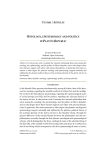
Ontology, epistemology and politics in Plato’s Republic
Статья научная
In the present work I examine the rational relationship that exists among the ontology, the epistemology, and the politics in Plato’s Republic, and to what degree these three theories support each other with rational foundations. In particular, this study examines to what degree the platonic ontology and epistemology support rationally and sufficiently the platonic political theory of the φιλόσοφοι-βασιλεῖς of the ἀρίστη πολιτεία in the Republic.
Бесплатно
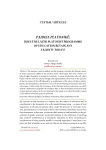
Статья научная
В данной статье я хотел бы рассмотреть вопрос о том, может ли тот способ обучения, который был характерен для античных платонических школ, представлять какой-либо интерес для современного образования? Мой вывод состоит в том, что, на самом деле, может, хотя и не повсеместно. В конечном итоге, образовательная программа, которая, после начального освоения правил рационального мышления и аргументации, сначала касается проблемы бытия как целого, а затем переход к таким более частным дисциплинам, как этика, политика, физика и метафизика, вполне подходит для воспитания широко образованного и рационально мыслящего человека. Мне кажется, что подлинным наследием платонической модели образования, от которой современная цивилизация постепенно отворачивается, является мысль о том, что подобающим образом структурированное изучение весьма абстрактных вещей - это лучшая тренировка для ума, даже если затем ему придется обратиться к решению полностью практических вопросов.
Бесплатно
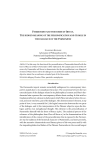
Статья научная
In this essay, the function of the personification of Parmenides himself with the horse of Ibycus in the dialogue of Plato’s Parmenides will be elaborated. The analytical process of this reference by Parmenides will focus to demonstrate that the personification is an allegorical element of Plato whose role in the dialogue is crucial for the understanding of the author's objective about the second more extended part of the Parmenides.
Бесплатно

Pavel Florensky on space and time
Статья научная
An investigation of the views on space and time of the Russian polymath Pavel Florensky (1882-1937). After a brief account of his life, I study Florensky’s conception of time in The Meaning of Idealism (1914), where he first confronts Einstein’s theory of special relativity, comparing it to Plato’s metaphor of the Cave and Goethe’s myth of the Mothers. Later, in his Analysis of spatiality and time, Florensky speaks of a person’s biography as a four-dimensional unity, in which the temporal coordinate is examined in sections. In On the Imaginaries in Geometry (1922), Florensky argues that the speed of light is not, as in Relativity, an absolute speed limit in the universe. When bodies approach and then surpass the speed of light, they are transformed into unextended, eternal Platonic forms. Beyond this point, time runs in reverse, effects precede their causes, and efficient causality is transformed into final or teleological causality, a concept on which Florensky elaborates in his Iconostasis. Florensky thus transformed the findings of Einsteinian relativity in order to make room for Plato’s intelligible Ideas, the Aristotelian distinction between a changing realm of earth and the immutable realm of the heavens, and the notion of teleology or final causation. His notion that man can approximate God’s vision of past, present and future all at once, as if from above, is reminiscent of Boethius’ ideas.
Бесплатно
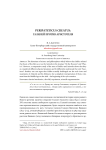
Peripateticus creatus: Галилей против Аристотеля
Статья научная
В историко-научной и философской литературе широко распространено мнение, что Г. Галилей опроверг теорию свободного падения, изложенную Аристотелем в трактатах «О небе» и «Физика». Однако сравнительное изучение текстов Галилея и Аристотеля показывает, что они рассматривали а) разные физические ситуации и б) по-разному понимали термин «тяжесть». Кроме того, Галилей фактически оспаривал не реальные взгляды и утверждения Аристотеля и его последователей, но их упрощенные трактовки, распространенные в Средние века и в XVI - начале XVII века, с которыми и полемизировал тосканский ученый.
Бесплатно
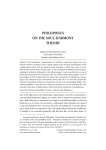
Philoponus on the soul-harmony theory
Статья научная
The Neoplatonic commentaries on Aristotle’s works have always been considered somehow suspicious. That is partly related to the doctrinal commitments of the commentators, partly with the hermeneutical strategies to which they seem to recur. Both of these reasons have also give place to the accusation of distortion and misunderstanding of Aristotle’s philosophy. In the following paper I want to perform an exercise of disclosing the hermeneutical procedure that one of this commentators applies to one of the passages of the first book of the De Anima. The commentator is Philoponus, the passage is the refutation of the soul-harmony theory. My aim is to show that, despite the doctrinal commitments that the commentator may have, his methodology follows Aristotelian guidelines. I hope that this could open perspectives on the value that the commentators must have as philosophers, rather than merely interpreters or paraphrasers
Бесплатно

Philosophical background of the cosmological polemics in Contra Manichaeos by John of Damascus
Статья научная
This article analyzes the philosophical arguments used by John of Damascus against the Manichaean dualist cosmological system in his Dialogue contra Manichaeos, showing some parallels with his Dialectica, and revealing a common Aristotelian background. The philosophical argument in the Dialogue seems to be a practical application of philosophical doctrines formulated in the Dialectica. From a wider perspective of anti- Manichean polemics used in part for instructional purposes for students of philosophy and theology in Late Antiquity, the conclusion is made that the purpose of the Dialogue was aimed not so much against the Manichaean cosmogony and cosmology, but against the Manichaean theodicy which might have been attractive to some Christians of John’s times.
Бесплатно
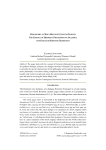
Статья научная
The paper deals with the concept of Hermetic philosophy presented in Pseudo-Apuleius' dialogue Asclepius, sive dialogus Hermetis Trismegisti . The attempt is made to describe the special characteristic of this philosophy and its spiritual dimension. Hermetic philosophy is not about solving complicated theoretical problems. Hermetic philosophy only wants to inspire and arouse the natural spiritual sensibility of its adept and open his mind to receiving the divine Mind (God).
Бесплатно
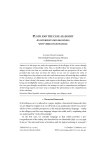
Plato and the cave allegory. An interpretation beginning with verbs of knowledge
Статья научная
In this paper we study the organization of the allegory of the cavern through the investigation of knowledge verbs. First, we briefly follow the interpretations of the allegory of the cave that we consider most significant and our perspective: all are valid provided that each does not deny the others. At our core we analyze the verbs of knowledge: how they relate to each other and what structure of knowledge they establish. In the conclusion, we affirm that the verbs do not present a vision of being as "what is", but as "what is being"; this means, with respect to the allegory, that the relation between being and intelligibility means a pathway of mutual equalization, which the prisoner of the cave goes through; nevertheless, the attempt to reach a comprehensive intelligence of the being requires one more step: to integrate the phenomena to the comprehension of the real thing.
Бесплатно

